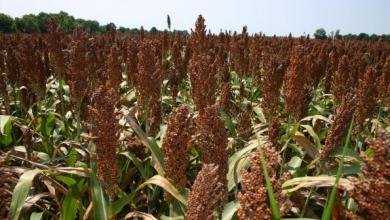
When is the best time to use a harvest aid on grain sorghum?
“Ideally, we want to put out a harvest aid at physiological maturity,” said Erik Larson, Mississippi State University Extension grain specialist, at the Aug. 13 Late Season Crops Field Day at the Delta Research and Extension Center in Stoneville. “When that occurs on the kernels, all the seed weight has already accumulated and (an aid) will have no negative impact on grain yield or test weight.”
Larson pointed to the white sugarcane aphid currently tormenting many Mid-South milo producers. “We are concerned about the potential of this insect, increasing populations, and basically running out of Transform applications before we can desiccate the crop and make it unpalatable to the aphids. Some folks may be looking to put out a harvest aid before the crop reaches physiological maturity. Unfortunately, that may have some negative consequences in terms of grain quality.”
For most Mississippi grain sorghum, the grain fill period is about 40 to 45 days. In terms of identifying when the crop has reached physiological maturity, “the grain fill is somewhat similar to corn. It goes through a ‘milk stage’ about 10 days after heading. Then, after 10 days, it will progress to the ‘soft dough stage’ then the ‘hard dough stage’ then to physiological maturity.
“As it approaches physiological maturity, the kernels will begin turning to a brownish-orange color to some extent. You probably won’t see it turn that color until the hard dough stage. The hard dough stage is best identified through a ‘fingernail test’ — like identifying the milk line in corn kernels. During the hard dough stage, hard starch will begin to form at the kernel top and progress downwards. That’s just like a corn kernel.”
This will occur a lot quicker in sorghum than in corn, said Larson. “If you can stick your fingernail into the top of a grain sorghum kernel easily, it still isn’t at hard dough. Hard dough stage is important because, at that time, you’ve only filled about 75 percent of your potential seed weight.”
Desiccate?
“If you desiccate too early — particularly with something like Roundup that will kill the plant — you’re probably going to lose up to 25 percent of your yield potential. You’re also going to cause the seed to die prematurely, which will reduce the seed weight. That, in turn, will reduce the test weight.
“So, you may quickly reduce your test weight to the point that the sorghum isn’t marketable at the elevator. You don’t want to go too early (with a harvest aid).”
When the sorghum kernel is physiologically mature, “you will be able to take your fingernail and not penetrate the seed coat.
“You’ll see a lot of variation (in maturity) out in the field. Your tillers and small heads will generally be the latest. But sorghum is quite a bit unlike corn in that instead of maturing over a two- or three-day period when everything is uniform it will mature over at least a 10-day period, maybe even more.
“That’s why it’s critical to do good field evaluations to ensure the harvest aid timing is appropriate.”
Source: Prepping for grain sorghum harvest: a few reminders | Management content from Delta Farm Press.

